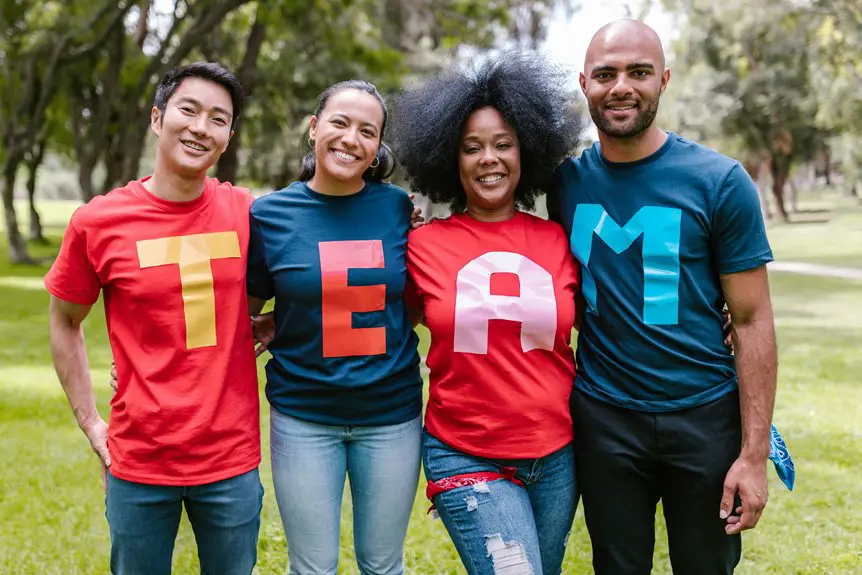Imagine a digital meeting room filled with diverse voices, each carrying unique perspectives shaped by their cultural backgrounds. In such environments, conflicts can easily arise, often stemming from misunderstandings or differing communication styles. Steering through these complexities requires a strategic approach that emphasizes clarity and respect. How can you foster an inclusive atmosphere where collaboration thrives, despite these differences? Let’s explore essential strategies to manage these cultural conflicts effectively.
Table of Contents
Key Takeaways
- Acknowledge and respect cultural differences in communication styles to prevent misunderstandings and foster a collaborative environment.
- Encourage open dialogue and active listening to address conflicts and promote understanding among team members.
- Provide training on cultural competence to help team members navigate cultural nuances and improve team dynamics.
- Implement regular check-ins and one-on-one meetings to facilitate discussion and resolve issues promptly.
- Utilize collaborative tools for anonymous feedback to create a safe space for team members to express concerns and share perspectives.
Understanding Cultural Differences in Virtual Teams
When working in virtual teams, it’s essential to recognize that cultural differences can greatly impact communication and collaboration. Each team member brings unique perspectives shaped by their backgrounds, which can influence how they express ideas and interpret feedback.
For instance, some cultures prioritize direct communication, while others may favor a more indirect approach. Understanding these nuances helps you navigate potential misunderstandings.
Cultural nuances in communication styles can lead to misunderstandings; recognizing these differences is key to effective collaboration.
It’s vital to be aware of varying attitudes toward hierarchy and authority, as these can affect decision-making processes. By actively seeking to learn about your teammates’ cultures, you foster an inclusive environment.
Encourage open dialogue and be respectful of diverse viewpoints. This awareness not only enhances collaboration but also helps you manage conflicts before they escalate into larger issues.
The Impact of Cultural Diversity on Team Dynamics
Cultural diversity can greatly shape how your team communicates and makes decisions.
You might notice that varying communication styles impact trust and relationship building among team members.
Understanding these differences is vital for fostering a cohesive and effective virtual team environment.
Communication Styles Variances
How do communication styles differ across cultures, and what impact does this have on virtual team dynamics?
In a virtual team, you may encounter varying communication styles shaped by cultural backgrounds. For instance, direct communicators value straightforwardness, while indirect communicators often rely on context and non-verbal cues.
This variance can lead to misunderstandings or conflict if not addressed. You might find some teammates prefer open discussions, while others may be more reserved, contributing to frustration or disengagement.
Being aware of these differences is essential. By fostering an inclusive environment that encourages adaptability, you can bridge communication gaps.
Encourage team members to express their preferences, ensuring everyone feels heard and valued, ultimately enhancing collaboration and reducing potential conflicts stemming from cultural misunderstandings.
Decision-Making Approaches
While diverse backgrounds enrich a virtual team, they can also lead to differing decision-making approaches that might complicate collaboration. Each team member brings unique perspectives influenced by their cultural values, which can clash during discussions.
To navigate these differences effectively, you should consider the following:
- Consensus vs. Authority: Some cultures prefer group consensus, while others value decisive leadership, impacting how decisions are made.
- Risk Tolerance: Different attitudes toward risk can affect how team members approach problem-solving and innovation.
- Time Orientation: Cultures may have varying timelines for decision-making, affecting urgency and responsiveness.
Trust and Relationship Building
Steering decision-making in virtual teams often reveals deeper issues related to trust and relationship building.
When team members come from diverse cultural backgrounds, their values and communication styles can clash. You might find it challenging to establish rapport, leading to misunderstandings.
To foster trust, prioritize open communication and be transparent about your intentions. Engage in active listening, showing genuine interest in your colleagues’ perspectives.
Building relationships takes time, so consider scheduling informal virtual gatherings to strengthen connections. Respect each other’s differences and leverage them for creative problem-solving.
Common Sources of Conflict in Culturally Diverse Teams
In culturally diverse teams, you’ll often encounter conflicts stemming from different communication styles.
Misinterpretation of norms and varying decision-making approaches can also create tension among team members.
Recognizing these sources of conflict is essential for fostering a harmonious virtual environment.
Communication Styles Differences
When team members come from diverse cultural backgrounds, their different communication styles often lead to misunderstandings and conflict. You might find that some team members prefer direct communication, while others use more indirect approaches. This disparity can create confusion and frustration.
To navigate these challenges effectively, consider the following:
- Cultural Context: Recognize that some cultures rely heavily on context, while others value straightforwardness.
- Feedback Style: Understand that some individuals may give and receive feedback more openly, whereas others might be more reserved.
- Non-Verbal Cues: Be aware that body language and tone can vary widely between cultures, impacting how messages are perceived.
Misinterpretation of Norms
How can misinterpretations of norms create friction in culturally diverse teams?
When team members come from different cultural backgrounds, they often have distinct expectations about behavior, communication, and collaboration. For example, you might view direct feedback as constructive, while someone else sees it as rude or confrontational.
These misunderstandings can lead to frustration and reduced trust among team members. If you’re unaware of others’ cultural norms, you might unintentionally offend someone or overlook their contributions.
Additionally, differing interpretations of punctuality or deadlines can cause conflicts in project timelines.
To mitigate these issues, it’s essential to foster open discussions about norms and expectations, ensuring everyone is on the same page and promoting a more harmonious working environment.
Decision-Making Approaches
Misinterpretations of norms can extend beyond communication styles and influence decision-making approaches within culturally diverse teams. When team members come from different cultural backgrounds, their decision-making styles may clash, leading to misunderstandings and conflict.
You might find that some prefer consensus-based decisions, while others lean toward authoritative directives. Recognizing these differences is essential for effective collaboration.
- Cultural Hierarchies: In some cultures, decisions come from the top, while others expect input from all members.
- Time Orientation: Some teams prioritize quick decisions, while others may take their time to guarantee thoroughness.
- Conflict Resolution Styles: Individualistic cultures may confront issues directly, whereas collectivist cultures might avoid confrontation to maintain harmony.
Understanding these factors can help you navigate potential conflicts effectively.
Strategies for Effective Communication Across Cultures
Effective communication across cultures is essential for the success of virtual teams, especially as differing backgrounds can lead to misunderstandings.
To enhance communication, start by being clear and concise in your messages. Use simple language and avoid idioms that may not translate well.
When discussing sensitive topics, approach them with respect and openness, showing a willingness to listen. Encourage team members to share their perspectives, fostering an inclusive environment.
Utilize visual aids and written documentation to reinforce understanding. Be mindful of time zone differences when scheduling meetings, ensuring everyone feels included.
Ultimately, when conflicts arise, address them promptly and constructively, focusing on solutions rather than blame.
Building Cultural Awareness and Sensitivity Among Team Members
While managing a virtual team, building cultural awareness and sensitivity among members is essential for fostering collaboration and understanding.
When you acknowledge the diverse backgrounds of your team, you create a more inclusive environment.
Here are some effective ways to promote cultural awareness:
- Encourage open dialogue: Create opportunities for team members to share their cultural experiences and perspectives. This helps everyone feel valued and respected.
- Provide training: Offer workshops or resources on cultural competence to help team members understand different cultural norms and practices.
- Celebrate diversity: Recognize and celebrate cultural events and holidays, allowing team members to share their traditions and customs.
Conflict Resolution Techniques Tailored for Cultural Differences
When managing conflicts in a culturally diverse virtual team, recognizing the unique perspectives of each member can greatly influence the resolution process. Here are some tailored techniques to reflect upon:
| Technique | Description |
|---|---|
| Active Listening | Pay attention to verbal and non-verbal cues. |
| Mediation | Involve a neutral party to facilitate dialogue. |
| Cultural Adaptation | Adjust your communication style to fit the culture. |
| Collaborative Problem-Solving | Work together to find mutually beneficial solutions. |
| Empathy Building | Encourage understanding of each other’s backgrounds. |
Encouraging Open Dialogue and Feedback in Virtual Settings
How can you foster an environment of open dialogue and feedback in a virtual team?
Start by creating a safe space where team members feel comfortable sharing their thoughts. Encourage regular check-ins and one-on-one meetings to discuss concerns openly. Use collaborative tools that allow anonymous feedback, ensuring everyone’s voice is heard.
Creating a safe space for open dialogue encourages team members to share their thoughts and concerns freely.
- Promote active listening: Show genuine interest in your team’s perspectives to build trust.
- Set clear expectations: Define how feedback should be given and received to minimize misunderstandings.
- Celebrate contributions: Acknowledge and appreciate team input, reinforcing that every perspective is valuable.
Leveraging Cultural Diversity for Team Innovation
Embracing cultural diversity within your virtual team can spark innovation and creativity, as varied perspectives often lead to unique solutions. By valuing different backgrounds, experiences, and viewpoints, you can encourage your team members to think outside the box.
This diversity fosters an environment where everyone feels comfortable sharing ideas, which can lead to breakthroughs that mightn’t arise in a homogenous group.
To leverage this cultural richness, actively promote collaboration among team members. Encourage brainstorming sessions where everyone can contribute, ensuring that quieter voices are heard.
You’ll find that these discussions often yield fresh, innovative approaches to challenges. Emphasize shared goals and celebrate the unique contributions of each team member, creating a culture where innovation thrives and everyone feels valued.
Best Practices for Sustaining Harmony in Virtual Teams
To sustain harmony in virtual teams, it’s essential to establish clear communication channels and set expectations from the start.
Regular check-ins and open dialogue help everyone feel included and valued. Encourage team members to share their perspectives and be respectful of cultural differences.
Regular check-ins and open dialogue ensure inclusivity, encouraging team members to share perspectives while respecting cultural differences.
- Foster an inclusive environment by celebrating diverse backgrounds and viewpoints.
- Utilize collaboration tools that facilitate real-time feedback and project updates.
- Create conflict resolution protocols that empower team members to address issues constructively.
Frequently Asked Questions
How Can Cultural Differences Enhance Team Creativity and Problem-Solving?
Cultural differences are like spices in a dish, adding vibrant flavors to your team’s creativity. By embracing diverse perspectives, you’ll spark innovative ideas and solve problems more effectively, turning challenges into opportunities for growth.
What Role Does Technology Play in Mitigating Cultural Conflicts?
Technology bridges gaps by facilitating communication, enabling real-time collaboration, and providing tools for understanding diverse perspectives. By leveraging these resources, you can foster a more inclusive environment, reducing misunderstandings and enhancing team cohesion effectively.
How Can Team Leaders Promote Inclusivity in Virtual Environments?
To promote inclusivity in virtual environments, you should encourage open communication, celebrate diverse perspectives, provide equal opportunities for participation, and actively seek feedback. These actions foster a sense of belonging and enhance team collaboration.
What Are the Signs of Unresolved Cultural Conflict in Teams?
Unresolved cultural conflict in teams can feel like a storm brewing. You’ll notice increased misunderstandings, withdrawal from discussions, negative body language, and hesitant communication. These signs often signal deeper issues that need addressing before they escalate.
How Can Organizations Measure Cultural Competence in Virtual Teams?
To measure cultural competence in virtual teams, you can assess communication effectiveness, adaptability, and team collaboration. Surveys, feedback, and performance metrics help identify strengths and areas for improvement, fostering a more inclusive work environment.




